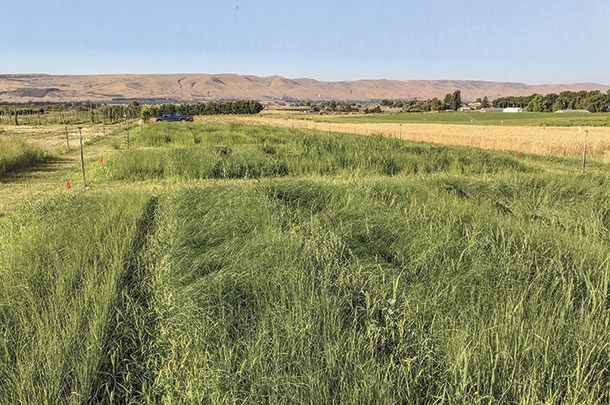The increasing urbanization of the American horse population has taken the horse further from its natural grazing patterns. The horse has become more sedentary and confined to smaller spaces, while also enjoying the benefits of ever-improving nutrition.
The caloric imbalance caused by this lifestyle has led to an explosion of overweight horses. As the size of girths increase, some progressive forage growers within the equine market will need to adapt to the shifting demographic. It will require a new way of looking at the forage crop produced with new objectives, new priorities and new market techniques.
It’s been estimated that nearly 20 percent of horses today are overweight or obese, predisposing them to laminitis – a devastating disease of the hoof that can lead to lameness or even euthanasia. That means 1 in 5 horse customers may be in search of lower-carb, lower-calorie hay. It also means horse owners are caring less about protein and more about the balance of carbohydrates (i.e., sugar, starches and fiber).
The primary treatment for laminitis and other metabolic diseases is: 1) lower the total nonstructural carbohydrates (NSCs) in the diet and 2) lower the caloric intake when overweight. More often than not, changes in hay are the ideal solution to their special needs.
Teff’s potential
Teff grass, a warm-season annual, was recognized as potential hay for metabolic horses several decades ago. However, limitations to its growth have stymied its availability and use in the equine industry. The unique thing about teff is due to its C4 nature; it metabolizes energy and stores carbohydrates differently than its C3 relatives: timothy, orchardgrass, bluegrass and cool-season grasses.
By understanding the growing and harvesting conditions of teff that influence the nonstructural carbohydrates (NSC) value, forage producers can grow a more reliable crop for the equine industry and give more farmers more options for summer rotations.
How to proceed
If you’re a forage grower looking for new niche markets and greater margin potential, low-carb horse hay, including teff grass, may be for you. But how do you prepare and adjust to these shifts in the equine demographic? 1) Educate, 2) test and 3) market.
Educate: Learn to speak “carb” jargon
First off, to be clear, all forages have the potential to be “low-carb.” From alfalfa to timothy, teff to bluegrass, the simple NSC levels are primarily a product of growing and harvesting conditions. Think of carbohydrates as a long spectrum of compounds starting with the most simple to the most complex. On the left side of the spectrum are the most simple compounds (think good ol’ table sugar).
On the far right side of the spectrum, the carbohydrates are very complex (think celery sticks and tree bark). The simple, left side of the spectrum is measured in a forage analysis as water-soluble carbohydrates (WSC), ethanol-soluble carbohydrates (ESC) and starch. The complex, right side of the spectrum can be estimated by acid detergent fiber (ADF), neutral detergent fiber (NDF) and lignin.
The optimal amount of nonstructural carbohydrates for a horse will depend on the type and severity of the disease, but in general, the lower, the better. The national average, according to Dairy One Laboratories, is about 13 percent NSC in mixed grass hays. However, many equine nutritionists will recommend diets lower than 10 percent NSC. Now, this may be difficult, though not impossible, to achieve year after year and cutting to cutting.
Test: Buy a forage probe and familiarize yourself with laboratory tests
When a horse owner asks for carb values, what they are asking for are the simplest carbohydrates reported as WSC, ESC and starch. When you add the WSC and starch percentages together on a dry matter basis, you get a value known as the NSC. Analytical laboratories can vary in how they package their tests for carbohydrates.
Be aware that most laboratories use near-infrared (NIR), which is limited for grass hays. Wet chemistry is preferred in this case over NIR for accuracy. There are two laboratories within the U.S. with packages designed for the equine industry: AgHealth Laboratories in Sunnyside, Washington, and Equi-Analytical (a division of Dairy One) out of Ithaca, New York.
Market: How to advertise your low-carb hay
In an attempt to create market consistency surrounding low-carb forages, I’ve created an online resource called Low Carb Horse Hay. This website attempts to bridge the communication gap between the forage grower and the horse owner concerned with carbohydrates. Here are just a few of the resources available to you as a grower.
- Consultation on how to grow low-carb hay
- Analytical laboratory packets to send samples
- Knowledgeable interpretation of results
- Lot pricing suggestions
- An equine nutrition expert to send your horse customers to for the more complex questions
- Online marketing, including website directory listing, Facebook posts and email newsletters

PHOTO: Washington State University teff grass research plots in Prosser. Courtesy photo.
If you’d like to learn more about this service, as well as research results on low-carb teff hay, please contact the author or visit Low Carb Horse Hay.

-
Natalie Shaw
- Low Carb Horse Hay Founder
- WSU MSAG Student
- Email Natalie Shaw











